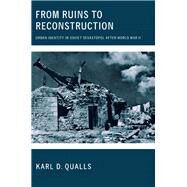From Ruins to Reconstruction
, by Qualls, Karl D.- ISBN: 9780801447624 | 0801447623
- Cover: Hardcover
- Copyright: 11/1/2009
Sevastopol, located in present-day Ukraine but still home to the Russian Black Sea Fleet and revered by Russians for its role in the Crimean War, was utterly destroyed by German forces during World War II. In From Ruins to Reconstruction, Karl D. Qualls tells the complex story of the city's rebuilding. Based on extensive research in archives in both Moscow and Sevastopol, architectural plans and drawings, interviews, and his own extensive experience in Sevastopol, Qualls tells a unique story in which the periphery "bests" the Stalinist center: the city's experience shows that local officials had considerable room to maneuver even during the peak years of Stalinist control. Qualls first paints a vivid portrait of the ruined city and the sufferings of its surviving inhabitants. He then turns to Moscow's plans to remake the ancient city on the heroic socialist model prized by Stalin and visited upon most other postwar Soviet cities and towns. In Sevastopol, however, the architects and city planners sent out from the center "went native," deviating from Moscow's blueprints to collaborate with local officials and residents, who seized control of the planning process and rebuilt the city in a manner that celebrated its distinctive historical identity. When completed, postwar Sevastopol resembled a nineteenth-century Russian city, with tree-lined boulevards; wide walkways; and buildings, street names, and memorials to its heroism in wars both long past and recent. Though visually Russian (and still containing a majority Russian-speaking population), Sevastopol was in 1954 joined to Ukraine, which in 1991 became an independent state. In his concluding chapter, Qualls explores how the "Russianness" of the city and the presence of the Russian fleet affect relations between Ukraine, Russia, and the West.







